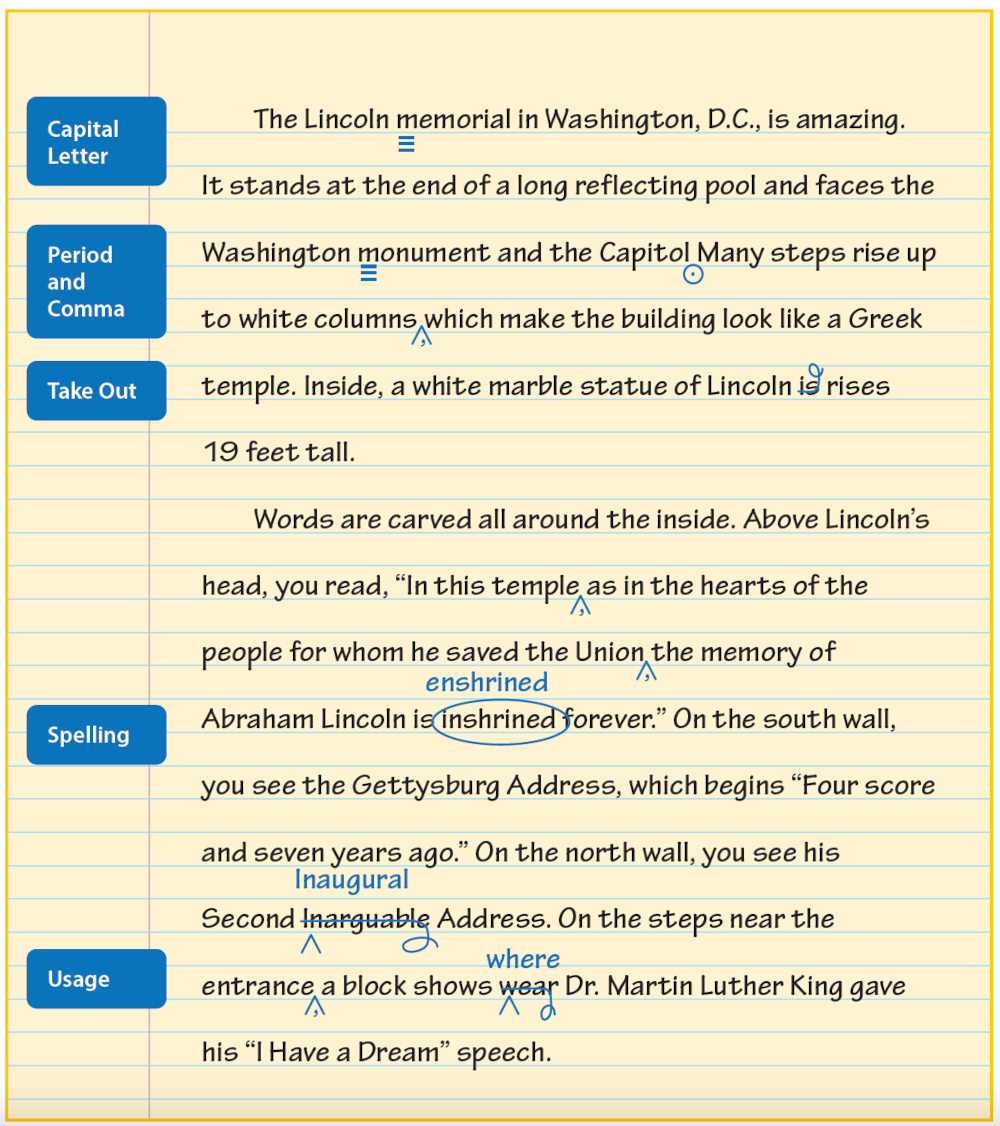Page 61

Editing
Have you ever looked out a dirty windshield? It’s hard to see where you’re going. All you see are the blotches on the glass.
That’s what it’s like to read writing that has a lot of errors. You get distracted by incorrect spelling, missing punctuation, wrong words, and other “blotches” in the work. Editing can get rid of those problems so that readers see where your ideas are headed.
After revising, you need to look at each word and punctuation mark. You should check your spelling and use an editing checklist. And, of course, your classmates and teacher can help you catch errors. This chapter shows you how.
What’s Ahead
WE 062
Page 62
Editing Tips
Editing can’t be done in a hurry. Instead, you need to take your time and check everything very carefully. Try to take a step-by-step approach using these tips as a guide.
Know Your Handbook 🟪 The “Proofreader's Guide” (see pages 431–489) at the back of the handbook lists all the conventions or rules for good writing. (See pages 64–65 for a guide to common errors.) Also use a dictionary, whether on your desk or online.
Edit on a Clean Copy 🟪 Start with a clean copy of your revised writing, skipping every other line. (This will make it easier to edit.) If you are using a computer, you can edit on the screen or print out a double-spaced copy to work on.
Use a Checklist 🟪 Using an editing checklist will help you focus on one type of error at a time. Without a checklist, you may try to check too many things all at once. (See page 66.)
Double-Check Your Spelling 🟪 A spell checker may not catch everything, so mark any word that you should look up in a dictionary. Then check each spelling.
Enlist an Editing Partner 🟪 Have a trusted classmate or family member check your writing, too. Other readers may find errors that you missed.
Tip The best advice for writers when they begin to edit their work is “Make every word count!” That means making sure your words are clear, specific, and correct—and changing those that aren’t.
WE 063
Page 63
Making Changes
The inside back cover of Writers Express has a list of common editing and proofreading marks. The sample below shows how you can use these marks when you do your editing.

WE 064
Page 64
Checking for Common Errors
Here are some common errors you should watch for when you edit.
1. Missing Comma in Compound Sentences 🟪 Be sure to place a comma before the coordinating conjunction (and, but, or, nor, for, so, yet) in a compound sentence.

2. Missing Commas in a Series 🟪 Use commas to separate three or more items in a series.

3. Confusing Its and It’s 🟪 Its shows possession, and it’s is a contraction for it is.

4. Subject-Verb Agreement Errors 🟪 Make sure all of your subjects and verbs agree. A singular subject takes a singular verb, and a plural subject takes a plural verb.



3. Confusing Its and It’s 🟪 Its shows possession, and it’s is a contraction for it is.

4. Subject-Verb Agreement Errors 🟪 Make sure all of your subjects and verbs agree. A singular subject takes a singular verb, and a plural subject takes a plural verb.



WE 065
Page 65
5. Missing Commas After Introductory Phrases and Clauses 🟪 Be sure to place a comma after phrases and clauses that introduce a sentence.

6. Writing Run-On Sentences 🟪 Use an end punctuation mark after a sentence, or connect two sentences with a comma and conjunction. Otherwise, your sentences will run together.

7. Using Double Subjects 🟪 A sentence is incorrect if it contains a double subject—a subject with a pronoun right after it.


WE 066
Page 66
Editing and Proofreading Checklist
Use this checklist as a guide when you edit and proofread your writing.
Sentence Structure
_____ Are the sentences clear and complete?
_____ Are the sentences easy to read?
Punctuation
_____ Does correct punctuation end each sentence?
_____ Do commas appear before coordinating conjunctions (and, but, or, nor, for, so, yet) in compound sentences?
_____ Do commas punctuate a series (bears, tigers, and lions)?
_____ Is dialogue correctly punctuated? (See page 144.)
Capitalization
_____ Does each sentence start with a capital letter?
_____ Are the names of specific people, places, and things capitalized?
Grammar and Usage
_____ Do subjects and verbs agree in number? (See pages 79 and 467.)
_____ Is the verb tense consistent?
_____ Is usage correct (to, too, two)? (See pages 456–465.)
Spelling
_____ Is spelling correct? (See pages 452–455.)
Teacher Support:
Click to find out more about this resource.
© 2025 Thoughtful Learning. Copying is permitted.
k12.thoughtfullearning.com